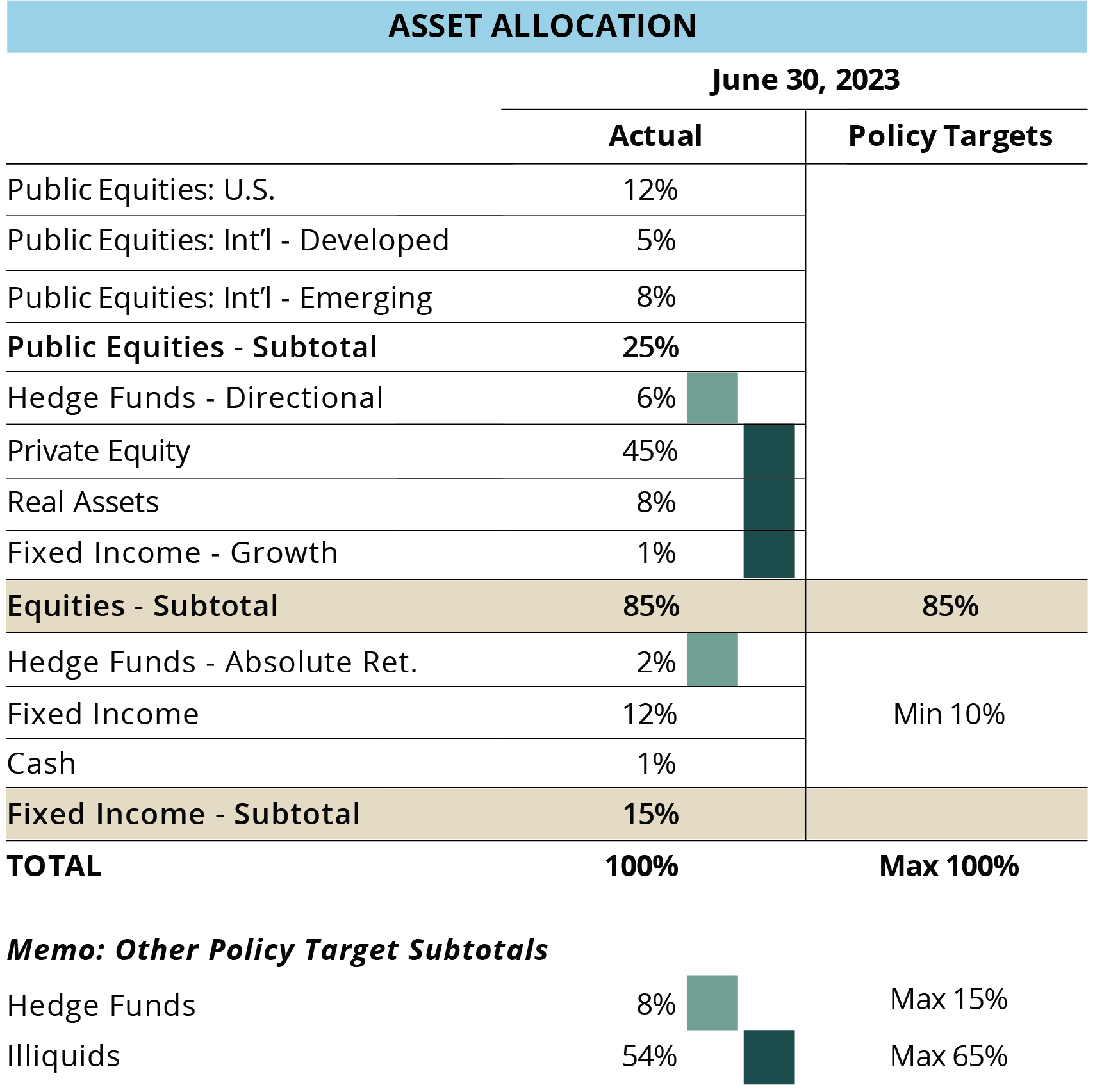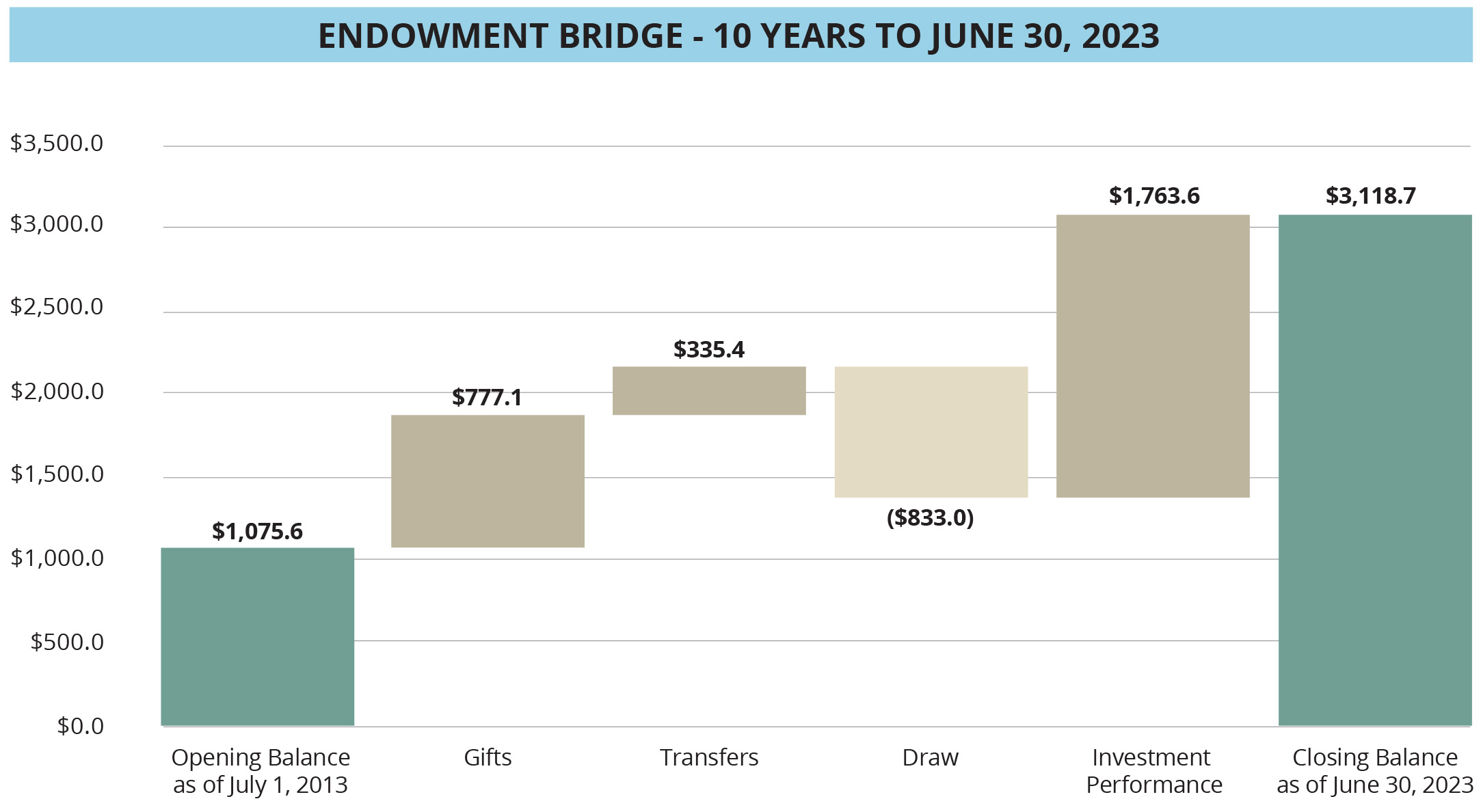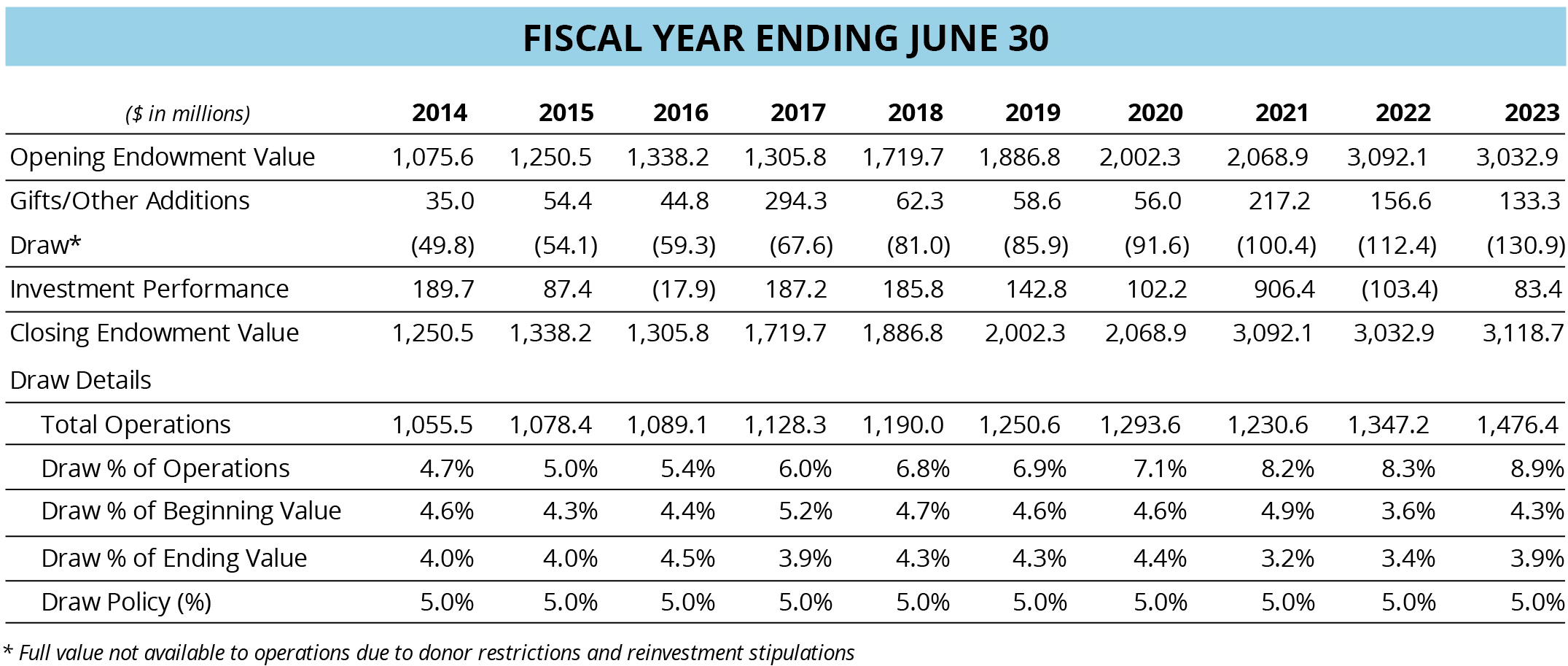Investment Highlights from
Charles A. Kennedy, Chief Investment Officer
Overview
Carnegie Mellon University’s mission seeks to make the world better by providing transformational research and education focused on advancing knowledge and understanding in science, technology, the humanities, business, and the fine arts. Carnegie Mellon’s endowment is a key strategic asset in achieving this mission. Created largely through incredible acts of philanthropy and augmented by careful financial stewardship, the endowment stood at a market value of $3.1 billion as of June 30, 2023.
By providing a permanent and consistent source of funding for scholarships, professors’ salaries, laboratory equipment, and other important needs, the endowment enables our faculty and students to fulfill the university’s mission. Critically, endowment support for tuition assistance allows Carnegie Mellon to attract and retain a highly qualified and diverse student body. With its perpetual life, the endowment is uniquely situated to provide funding today, tomorrow, and for future generations to advance the university’s mission and to help our students and faculty achieve their goals and aspirations.
Advancing Carnegie Mellon to Advance Humanity
As announced in April 2023, Carnegie Mellon’s fundraising campaign surpassed its initial financial goal of $2 billion more than 18 months ahead of schedule. Carnegie Mellon has extended the campaign to June 30, 2025 to capitalize on this impressive momentum for several priority initiatives, including continuing to expand access to a life-changing CMU education; enhancing the CMU experience, including through key capital projects; supporting faculty; and elevating significant initiatives within each college as well as University Libraries. This timeframe also coincides with the 125th anniversary of the founding of the university’s originating institution, the Carnegie Technical Schools, which was established through the original philanthropic gift from Andrew Carnegie.
As of June 30, 2023, over 61,000 supporters of Make Possible: The Campaign for Carnegie Mellon University have committed almost $2.2 billion to accelerate Carnegie Mellon’s strategic priorities in education, research, and societal impact. Over $925 million of the new commitments are for the endowment.
In February 2023, Carnegie Mellon and the Norman and Ruth Rales Foundation announced the CMU Rales Fellows Program, a transformative new initiative to expand access to select master’s degree and Ph.D. programs in the science, technology, engineering, and math (STEM) fields for students from under-resourced and underrepresented backgrounds — including first-generation students — by providing full tuition and a stipend to cover living expenses, housing, and health insurance. The program will also support students through a distinctive, holistic ecosystem of developmental and networking opportunities that will benefit Fellows both during their time at Carnegie Mellon and as they advance in their careers.
The Rales Foundation gift will provide an endowment of $110 million to support the program, and Carnegie Mellon has committed a further $30 million in endowed funds. The two organizations also are jointly establishing a $10 million fund to support the program’s developmental years.
Strategy and Allocation
The endowment’s portfolio of investments is managed with a long-term, growth-oriented view and is evaluated by its effectiveness in achieving — over time — two fundamental objectives: (1) generating steady and substantial financial support for students, faculty, and programs; and (2) balancing current demands for support with the goal (at a minimum) of maintaining the endowment’s real purchasing power for future generations (i.e., preserving intergenerational equity). To maximize long-term expected returns within acceptable levels of risk and liquidity, Carnegie Mellon designed its policy asset allocation using a combination of academic theory, quantitative analysis, and informed market judgment.
To achieve the objectives stated above, Carnegie Mellon targets broad portfolio exposure of 85% in equity investments for long-term growth and appreciation, and 15% in fixed-income investments to provide stability and liquidity. Fiscal Year 2023 (FY23) marks the 19th anniversary of the university’s decision to shift the equities focus from traditional, publicly traded investments to private investments, primarily utilizing private equity funds globally. We believe that over the long term, private equity investment returns, including those from emerging markets funds, will exceed the returns generated from investing in public securities.
Environmental, social, and governance (ESG) issues can affect the performance of investment portfolios (to varying degrees across companies, sectors, regions, regulatory regimes, asset classes, and through time). Attention to ESG issues by investors and company management teams encourages accountability, transparency, forward-looking perspective, and ethical behavior in business practices, which may lead to reduced exposure to various risks, sustained financial performance, and improved long-term value creation. Importantly, the university does not pursue ESG investing as a strategy distinct from its central investing focus. Carnegie Mellon integrates ESG factors into its multifaceted investment analyses and expects investment managers to do the same. We gain insight into our managers’ ability to persistently improve the operations of their portfolio companies by monitoring their incorporation of ESG initiatives into value creation strategies.
Given return dispersions that can persist for extended periods of time across asset class categories, Carnegie Mellon updated its asset allocation model during Fiscal Year 2022. The updated model allows more flexibility to concentrate capital with managers pursuing themes and strategies with multigenerational return potential while maintaining ample portfolio liquidity. Figure 1 details asset allocation targets and actual allocations as of June 30, 2023.
Figure 1: Asset Allocation – Actual Allocations and Policy Targets

As depicted in Figure 1, the endowment is at its 85% equities target and well within other policy constraints. As we mark the 19th anniversary of the university’s long-term strategy, Carnegie Mellon’s investment program is maturing. However, the nature of private equity investing and the growth of Carnegie Mellon’s endowment necessitate a continued focus on expanding our best private equity relationships and identifying the next generation of top tier managers. Fortunately, Carnegie Mellon’s endowment is of a size that permits new, reasonably sized commitments to value-creating investment managers that will be meaningful to the endowment’s asset allocation and investment return.
Investment Performance
The university’s net investment return for FY23 was 2.9%. More significantly, given the long-term goals of the investment strategy and the “noise” (versus signal) often associated with short-term equity results, Carnegie Mellon’s three-, five-, and 10-year returns were 12.4%, 10.1%, and 9.9%, respectively. These returns compare favorably with relevant benchmarks.
Endowment Attribution
The endowment’s market value increased to $3,118.7 million as of June 30, 2023, from $3,032.9 million as of June 30, 2022. This net increase of approximately $85.8 million reflects the collective impact of $133.3 million from gifts and other sources, plus $83.4 million from net investment gains, less $130.9 million of distributions to support the university’s operations.
As depicted in Figure 2, for the 10-year period ended June 30, 2023, the endowment’s market value increased approximately $2,043.1 million (from a beginning market value of $1,075.6 million), reflecting the collective impact of $1,112.5 million from gifts and other sources, plus $1,763.6 million from net investment gains, less $833.0 million of distributions to support the university’s operations.
Figure 2: Endowment Bridge
(dollars in millions)

As previously noted, cash distributions from the endowment (i.e., the draw) provide a key source of support for various university activities and programs in need of consistent funding ranging from general operations to scholarships and professorships. During the last decade, the draw from the endowment has grown from less than 5.0% of the university’s operations to 8.9% for FY23. Overall, the draw grew both in absolute terms and relative to the operating budget of the university (which grew 3.7% annually over the decade), while following a consistent draw policy in place since 2004 (see Note 7 on p. 23 of the consolidated financial statements). Even with the higher level of support, the university’s endowment contributes only about one-third of the relative operating support received by many academic peers from their endowments. This variance leaves Carnegie Mellon more dependent on tuition and sponsored research than its peers. Consequently, Carnegie Mellon remains focused on growing the endowment to assure the financial resources and flexibility exist to successfully pursue its long-term research and education mission.
The historical activities of the endowment, including the draw and its support expressed as a percentage of annual operations, are summarized in Figure 3.
Figure 3: Endowment Values and Attribution

The Dietrich Foundation
The Dietrich Foundation, established by Pittsburgh industrialist and longtime university trustee William S. Dietrich II, was created to manage in perpetuity his gift of approximately $500 million in assets intended to benefit the university and other higher education and charitable institutions. The Dietrich Foundation’s assets are not reflected in the university’s financial statements (see additional information regarding the foundation in Note 17 on p. 39 of the consolidated financial statements). The university’s share of the annual distributions from The Dietrich Foundation is 53.5%. If this percentage is applied to the estimated value of The Dietrich Foundation’s assets of $1,438.1 million as of June 30, 2023, and the result added to Carnegie Mellon’s endowment of $3,118.7 million, the combination would total $3,888.1 million. Annual distributions from The Dietrich Foundation over time equal 3.0% of the value of the foundation’s net assets as measured on January 1 of each year. The Dietrich Foundation’s gift added to Carnegie Mellon’s endowment for FY23 was $27.7 million, and cumulative gifts since the initial gift in Fiscal Year 2013 have totaled $161.8 million.
Summary
Carnegie Mellon’s endowment provides an important and permanent source of financial and operational stability, which helps university leadership perpetuate academic and research excellence in a rapidly changing and increasingly competitive world. The enduring generosity of alumni and friends, combined with an investment program focused on compounding net returns for the long term, should continue to increase the value of the endowment over time. Thus, Carnegie Mellon’s endowment will continue to provide ongoing support for the university’s operating needs, while preserving purchasing power to support future generations of students and faculty.
Sincerely,

Charles A. Kennedy
Chief Investment Officer
November 2, 2023